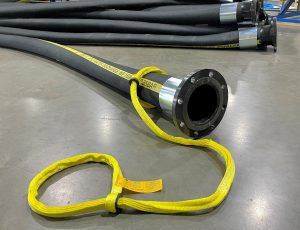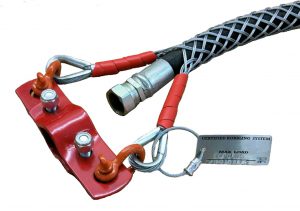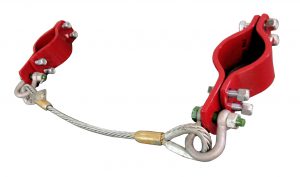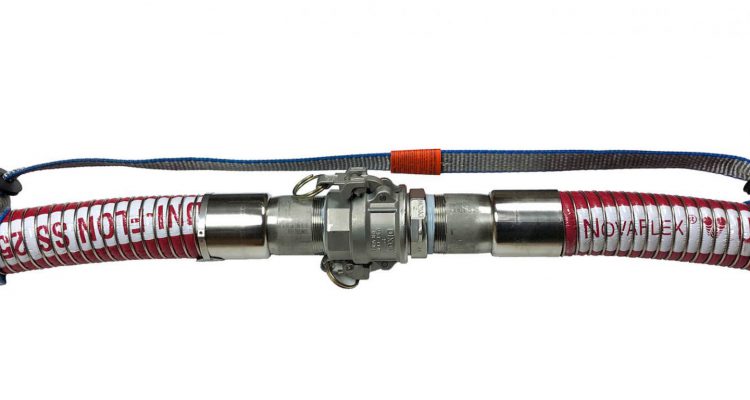
Hose safety whip restraint products drastically reduce the risk of damage and serious injury should a hose become disconnected under pressure. A correctly installed safety device will hold the hose in-check until pressure can be relieved and can also contain hazardous spills. An unchecked pressurized hose can be deadly, even at moderate pressure. There are many types of hose safety restraint systems designed for various applications. This post discusses the various types and their benefits, as well as how best to install them into your hose system. Selecting an appropriately matched system is the first step towards a safe work environment. It is also imperative to have proper installation, education, and replacement of these devices to ensure compliance and job safety.

Hose safety whip check cables are designed for moderate pressure air service (under 200 PSI) on pneumatic powered tool lines. These cables should be installed with no slack, and come in hose-to-hose, and hose-to-tool end loop styles. A hose whip check cable is designed to fit a range of hose sizes. A 3/4-inch hose connected to a 1-inch hose can utilize the same cable size; the spring loops allow adjustment while maintaining a snug fit. Hose-to-tool versions must have a location on the tool to fit around without slipping if the hose were to fail. A poorly fitted whip check cable that can slip off of the tool or hose assembly will not have any benefit in a hose failure event. Hose safety whip check cables are also offered in stainless steel with bronze ferrules. Inspect your whip check cables regularly, especially in outdoor or corrosive environments and replace when needed. A worn or corroded safety device may snap under the force of a failed hose.
Hose choker cables are a higher pressure rated and heavy duty upgrade from the hose safety whip check product. These perform and install similarly but can also be customized to specifically meet your hose application and size. The loop ends, while still adjustable to meet varying outside diameters, have a smaller range and must be ordered per hose size. The loops also utilize a custom nylon spool that will cinch the cable tighter during a failure. The choker ends offers a strong grip while also reducing the flow of spilling fluid or gas. While choker cables offer a higher pressure range, they too must be inspected regularly and replaced when signs of wear or aging exist. Hose Choker cables can also be fabricated in stainless steel, with hook ends for versatile installation, and with field install ends which allow for installation without breaking the hose connection.
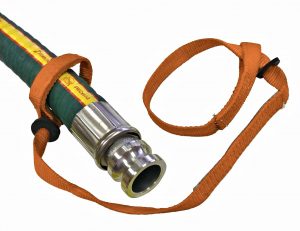 Nylon safety restraints offer a versatile non-metal safety device for a variety of hose applications. They include widely adjustable loop ends and come in a range of lengths. Nylon safety restraints can be double wrapped (figure-8 style) to make for an even stronger connection. Installation does not require the disconnection of a hose line, making this a beneficial option where semi-permanent connections would be time consuming to disassemble. Nylon hose restraints come in single and double ply, up to 4-ply custom designed, which covers a broad range of applications. A short nylon restraint can be used to secure a Whip Stop or Choker Cable around a piece of equipment.
Nylon safety restraints offer a versatile non-metal safety device for a variety of hose applications. They include widely adjustable loop ends and come in a range of lengths. Nylon safety restraints can be double wrapped (figure-8 style) to make for an even stronger connection. Installation does not require the disconnection of a hose line, making this a beneficial option where semi-permanent connections would be time consuming to disassemble. Nylon hose restraints come in single and double ply, up to 4-ply custom designed, which covers a broad range of applications. A short nylon restraint can be used to secure a Whip Stop or Choker Cable around a piece of equipment.
Our nylon safety restraint is designed and tested specifically as a hose restraint and not for sling or harness applications. It is important to ensure that the nylon loop will not slide off of a slick covered hose. Inspect and replace nylon restraints in outdoor service every 2 years or at first sign of deterioration. For sizes, types, and pressure ratings visit the product page link above.
- The use of rubberized or self sealing tape to build a retaining lip on the cover of urethane & small diameter hose is recommended
- Further safety and installation information can be found at the following instructional product PDF
The Hose Whip Stop System is designed for very high pressure applications and those where a hose failure event could be catastrophic. Also known as hose whip socks, these tested hose safety products can be shackled either to another whip stop or to a hobble clamp (shown in red). The hobble clamp can be secured to a suitable pipe or rail and can be custom designed. The loop-legs can also be made longer for a greater reach, however ensure that there is not any slack in these, which can allow moderate hose blow-back in a failure event.
- 4-leg versions are available – A single whip stop restraint can secure both sides of a short hose assembly
- Rubberized or self-sealing tape can be applied to ensure the blank end stays in place on the hose during use
The Hobble Clamp Hose Restraint, (or clamp X anchor restraints) bolt directly around the outside of a heavy walled hose or pipe. These devices are offered by special quote only to ensure safety and compliance on API and oilfield applications. This safety system can utilize hobble clamps of equal or varying sizes for connecting hose to pipe of a larger diameter, or as hobble clamp X anchor plate (see below). The center link is made from chain or braided wire. The hobble clamps can also be hinged for simple removal and reattachment. These heavy duty hose restraints are common in off-shore and oilfield applications and provide versatility where either a Hose Whip Stop cannot meet the pressure, or the hose cannot be easily disconnected.

A Flange Anchor Plate is a convenient and secure accessory to connect a Whip Stop or Choker Cable to a hose to flange installation. The Anchor plate is offered in 3 sizes to cover a range of hose and flange diameters. Anchor to the hose assembly’s mating flange utilizing any of the flange bolts already in use (may require longer bolts to account for anchor plate thickness of 3/8 to 1/2 inch. A shackle secures the hose restraint to the flange anchor for a permanent secure connection.
Remember that installing a whip restraint product does not ensure that it will prevent damage or injury during a hose failure. It must be properly matched, and properly installed. Should a hose failure occur, replace your hose whip restraint. A used safety restraint could have concealed damage or deterioration. A restraint that has been in a blowout situation is like an airbag that has already deployed. It may have incurred damage and a new one should be installed. Check your safety products regularly and educate the staff who will be using them. Keep additional inventory on hand for replacements and new installations. It could mean the difference between a quickly recoverable failure and a far more serious incident.

